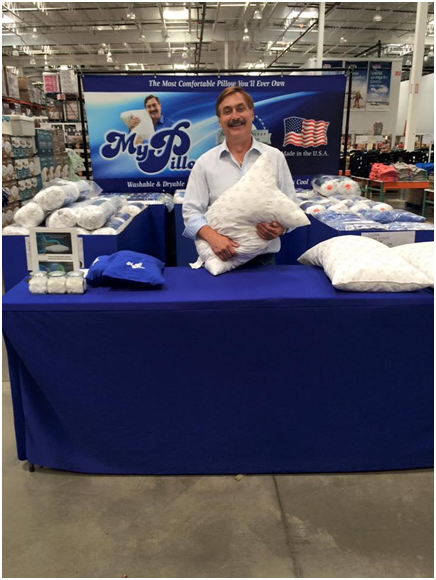How MyPillow Exploded from 5 Staff to 500 in 40 Days
Updated on July 15, 2021Have you heard of MyPillow?
Most likely the answer is yes. It’s EVERYWHERE!
You may have even seen this:
Now, I have to tell you:
I own several of these pillows, and I LOVE THEM. It really is a fantastic product.
But the truth is…
A great product alone isn’t enough to build a successful business. People have to know it exists. And you have to create want!
It’s the same thing I am always saying:
If you want to grow your small business, you have to market your products or services A LOT.
It’s how I grew my business and it’s how I’ve seen SO MANY of my own clients grow theirs, too!
However…
I can shout about this until I’m blue in the face, but because I own a marketing company (which stands to profit from marketing), a lot of you may dismiss it.
So I wanted to bring you a different kind of marketing story…
Maybe if you see all the marketing that goes into a large, well-known business at the beginning (you know, the stuff they don’t usually talk about once they get that big), you’ll have an “a-ha moment” yourself!
So I started looking for super successful people to interview. MyPillow was my first choice, and Mike Lindell, the man who invented it, was kind enough to talk to me!
Mike’s marketing budget is…
Are you ready?
$1 million to $2 million per week.
Yep. PER. WEEK.
Now:
MyPillow generates $280 million in annual revenue. (My company, by contrast, generates $49 million in annual revenue, and we spend about $90,000 per week on marketing.)
Of course, he didn’t start out marketing that much! Nobody could!
Read on to learn the three marketing actions that helped propel MyPillow into the stratosphere! (And stay tuned: I hope to bring you more interviews like this in the future!)
Marketing Step No. 1: Learn from every encounter and use it to inform your business growth strategy.
When Mike invented MyPillow, he got turned down everywhere ⎯ no place wanted to sell it.
So he got his humble beginnings at a mall kiosk. And he didn’t do very well there.
But it was at that kiosk that he met (and actually sold a pillow to) the guy who ran the Minneapolis Home & Garden Show, which helped Mike get his foot in the door there.
He spent the next 7 years at home shows and fairs, networking and talking to his customers so he could learn their needs and wants.
Here’s a photo of Mike at an old MyPillow booth:

(Photo courtesy of MyPillow)
Not very glamorous, but it doesn’t matter! He was out there learning about his customers and his market. That was time well-spent…
As he sold more and more pillows, he realized that what worked was telling his OWN story — which is that he had a terrible time finding a comfortable pillow, so he decided to invent one himself!
His experience selling at home shows taught him two things:
- Who his customers and ideal prospects were (Baby Boomers), and
- What kind of message resonates with them (an authentic story of a guy and his problem that they could relate to)
Mike: “When you start in the trenches, in the home shows and fairs, you hear back directly from your customers.”
He also paid attention to what his competitors were doing.
Mike: “The internet is a great tool for learning — about other products and how they’re advertising. I learned from a bedding company and a direct competitor, I learned the ins and outs of Amazon.”
This is something I preach to any business owner that will listen ALL THE TIME:
You don’t have to reinvent the wheel. Look at what’s working (or not working) for other businesses and use that to inform your marketing!
You know…
That old photo of Mike sort of reminds me of something:

I hate that picture! But it’s a good reminder of how far I’ve come. We ALL start out small!
Those early days of MyPillow gave Mike the foundation he needed to grow his company in a major way — with cost-effective marketing!
Mike: “I believe if everybody knew where to spend their advertising dollar, the products could be so much cheaper in this country. But nobody knows where to advertise. You need to really know your audience and you got to know where to get to them.”
Download this FREE worksheet to learn how to correctly identify your target market!
The lesson:
Talk to your customers and prospective customers.
You can learn:
- Who they are. When you know who your customers are, you know who your future customers are likely to be — people just like them! And that’s who you should target with your marketing.
With a high-quality mailing list, you can target your postcard recipients by location, age, gender, income, whether or not they have children, home value and a lot more — even interests and hobbies!
- What problems they have. When you understand your prospects’ pain points, you can reach them with a very specific message that tells them you understand — and can help them.
For example, if you’re a pest control company in Florida whose prospects’ biggest frustration is battling mosquitos, you craft your message around that. Instead of saying, “We’re the best pest control service in town,” you say, “We’ll help you get rid of mosquitoes for good!” See the difference? Make it about them ⎯ not you.
- How you can solve them. Unless you are in a niche industry, you probably have competitors — lots of them. Developing a unique selling proposition (USP) gives you an edge and makes you the clear choice.
A USP is something that ONLY YOU can offer. Mike’s USP is that MyPillow will be “the most comfortable pillow you’ll ever own.” He also offers a 10-year warranty and a 60-day money-back guarantee! (Everyone loves a guarantee!)
So if you were that pest control company, your USP could be something like, “If you find a mosquito in your yard within 10 days of your last treatment, we’ll treat again for FREE!”
Good or bad, there is something to be gained from EVERY experience. And learn from other businesses’ successes and failures, too!
Step 2: Don’t be afraid! Test your theories. Try different approaches and track your results.
In 2011, something amazing happened:
The Minneapolis StarTribune published a human-interest story in the business section about Mike and MyPillow ⎯ and his sales took off.
And that dictated his next brilliant move:
Mike: “I wanted to duplicate that. I made my own print ad ⎯ me holding my pillow, and I wrote what my problems were and how I solved them.”
The response was off the charts.
Like any good marketer would, Mike geared up to replicate that success in a big way.
He ran that ad literally in every paper in the country, and figured out which markets and newspapers generated the best return on his investment.
Mike: “I’ve been in the New York Times, Wall Street Journal, USAToday, hundreds ⎯ thousands ⎯ of times. It resonated with people because it was real. It was like an advertorial.”
And like any GREAT marketer would, Mike re-invested his wins from his newspaper ads into continuing to grow his business.
This is important because I know plenty of business owners who wouldn’t have continued pushing the boundaries.
Here’s the point:
Your marketing budget should be a percentage of your annual revenue (what percentage depends on what your business goals are). Which means that as your revenue grows, so should the amount you spend on marketing!
Download our free marketing budget calculator to find out how to meet your revenue goals!
Mike was ready for the next step. Still unable to get into any of the big stores, he decided to take MyPillow to his audience directly with an infomercial.
His friends told him infomercials were hokey and old-school, but he had a hunch it would work — and he was right.
Mike: “I would do something else if I was targeting Millennials ⎯ social media, etc. But not TV, and certainly not newspapers… But when I did that infomercial, I went from 5 employees to 500 in 40 days. It was insane.”
Mike also tried radio advertising, and after some trial and error, figured out which stations generated the best results.
Mike: “You’ve just got to test it. You can test radio for $1,000. Go to the little (radio stations)… You’re never going to hear me on a radio station that’s for 20-40 year olds.”
Mike also targets his audience with my personal favorite:
Mike: “With the U.S. mail, you can actually do more filtering than any other place. We can mail to every single customer we’ve ever had, once every 2 to 3 months.”
And he is still marketing MyPillow in person, talking to customers. Here he is recently at Costco:

(Photo courtesy of MyPillow)
The lesson:
If you have a great product or service, the more you market it, the more you will sell. It’s just a fact.
Of course, I don’t expect small business owners to spend $1 million or even $90,000 per week on marketing!
When I first started PostcardMania, I mailed out 1,000 postcards per week (which cost about $400) marketing my services. Today I mail 180,000 postcards a week, plus I do pay per click, social media and email marketing!
But my point is:
Find out what works for your product and then spend as much as you can afford to. And as your revenue grows, so should your marketing budget.
That’s how you grow a business. Continuously.
And you have to be open to testing your presumptions (and being wrong sometimes)…
Step 3: Prioritize real, hard numbers over emotions and anecdotes and LEARN from them — for real!
When I asked Mike what advice he’d give someone with a much smaller business, here’s what he said:
Mike: “My best answer is you have to test. Don’t put all your eggs in one basket. Test print, test Facebook, etc. But you’d better know what your response is… We track every single piece of marketing.”
He says he wishes he could help business owners to be less afraid of jumping into marketing
Mike: “Test a bunch of things, then cannonball into the one that worked. What’s the worst that can happen? I’ve had to borrow money from friends and pay them back the next week.”
The key, he says, is to learn from it.
Mike: “Deviations are important to look at. What happened to my sales that they went down that week? Why did this work out well and why did this other thing fail?”
(This was super interesting for me to hear because we do the exact same thing. We have metrics for everything and we watch them weekly, so we can make changes where needed to improve our marketing!)
Mike has the numbers down to a science — he knows where he gets the best return on investment and how much revenue he can expect to bring in with his marketing budget.
The lesson:
Try different kinds of marketing to find out what works best for your business. And you won’t get anywhere without rigorous tracking.
I know tracking sounds really unsexy…
But when you consider the alternative — potentially wasting your hard-earned money on ineffective marketing — you understand how important it is!
You can (and should) ask every single lead who reaches for your business how they heard about you, but the fact is: The answer they give may not be totally accurate.
Maybe they heard your radio spot, and then they received your postcard. Then, when they needed what you offer, they did a Google search generically and because of the new familiarity they clicked on your website.
So when you ask them how they heard about you, they shrug and say, “online.”
Today’s technology provides incredible tracking capabilities that not only help you understand how your marketing campaigns are performing, but can actually teach you a lot about your business.
A quick story:
One of my consultants told me recently about a client of his (a dentist) who had decided not to send out any more postcards. She said her last campaign didn’t bring in many new patients (and her front staff agreed).
Fortunately, this client uses DirectMail2.0 (which adds mail tracking, call tracking and Google ads to your postcard campaign), so my consultant pulled the client’s call tracking to see what was really going on.
(A call tracking number rings directly into your business but goes through the cloud first, where it is counted and recorded.)
She was able to see that the postcard in fact did bring in a bunch of calls, and that her front staff were actually mishandling them!
So commit to a campaign (I recommend at LEAST 6 months — 12 is better), track the results accurately with technology, and figure out where you’re getting the best return on investment (ROI) so you can strengthen those efforts to generate even BETTER results!
And:
Then you’ll know which marketing efforts you need to cut back and tweak until you get a good enough ROI to roll it back out, or pull back entirely if the cost becomes unjustifiable.
Mike’s final piece of advice? Don’t be afraid of failure.
Mike: “If you do make mistakes it’s not the end of the world. Sometimes the mistakes are the most important part of being an entrepreneur… I’ve made every mistake. At the time it might feel devastating, but you look back 6 months later and you go, ‘Wow, that HAD to happen.’”
Talking to Mike was such an honor — he is a marketing genius who is passionate about his product, and just an awesome guy.
I hope you’re feeling as inspired by his story as I am!
Call my consultants at 800-628-1804 if you have any questions about your marketing or to get started on your next campaign — or email me directly at Joy.Gendusa@PostcardMania.com.
Best,
Joy

8 Comments
Glad you liked it, Dave! Thanks for sharing.
Well constructed and ‘value packed’ article. Putting this one in my archives!
I’m so glad you enjoyed it, Mario! Thanks for reading!
I love this type of article because it shows that if you love your product or service…..if you nurture it and believe in it, your dreams will come true.
So true, Cathy! Thanks for your comment!
Great article. The MyPillow story is pretty amazing. Wanted to point out a typo that I noticed In the header of the download image it reads “Know They Customer”, not “Know Thy Customer”. Just thought you’d want to know.
LOL I totally missed that. Thanks Don! I’ll get that fixed!






Great article. Love hearing the success stories. Thanks for sharing. The 3 steps are worth studying along with the other gems you mentioned in them like… Staying close to the customer, adapting, testing, tracking results, and committing to consistent marketing are keys to success. We’ve been in the marketing business for the past 26 years. The ones who followed through on the steps tend to be the big winners in the long haul.